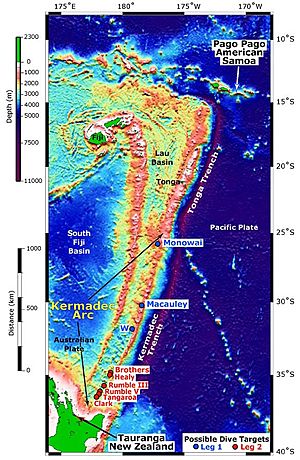Tonga-Kermadec Ridge facts for kids
The Tonga-Kermadec Ridge is a long underwater mountain range in the south-west Pacific Ocean. It runs beneath the Tonga and Kermadec Islands. This ridge is one of the most active places on Earth where subduction happens. Subduction is when one of Earth's huge plates slides under another. Because of this, it has many submarine volcanoes and lots of earthquakes.

What is the Tonga-Kermadec Ridge?
The Tonga-Kermadec Ridge stretches for more than 3,000 kilometers (about 1,860 miles). It goes north-northeast from New Zealand's North Island. Here, the Pacific Plate is sliding westwards. It goes underneath the Australian Plate.
The ridge is split into two main parts:
- The northern Tonga Ridge.
- The southern Kermadec Ridge.
These two parts are separated by the Louisville Seamount Chain. A seamount chain is a line of underwater mountains.
How it Works
On the western side of the ridge, there are two areas called back-arc basins. These are the Lau Basin and the Havre Trough. These basins started forming millions of years ago. The Lau Basin began opening about 6 million years ago. The Havre Trough started about 2 million years ago.
Together, the ridge and these basins form a huge system. This system is called the Lau-Tonga-Havre-Kermadec arc/back-arc system. It has been moving eastward for about 100 million years.
The stretching in the Lau-Havre basin makes the Pacific Plate slide under the Australian Plate faster. This movement causes the Tonga-Kermadec Ridge to move on its own. It acts like its own small plate, called the Tonga-Kermadec Plate. This plate is even broken into smaller pieces. These smaller pieces are called Niuafo'ou, Tonga, and Kermadec microplates.
Hotspots and Plateaus
Hotspots are places where hot rock rises from deep inside Earth. The Samoa and Louisville hotspots affect the volcanoes on some northern Tonga islands. These islands are Tafahi and Niuatoputapu.
The Louisville Seamount Chain is made of rocks that formed 80-90 million years ago. These rocks started to slide under the Tonga-Kermadec Ridge about 8 million years ago.
Large areas of volcanic rock are called large igneous provinces (LIPs). The Hikurangi Plateau and Manihiki Plateau are north and south of the Tonga-Kermadec Ridge. They are part of the Ontong Java-Hikurangi-Manihiki LIP. This was the biggest volcanic event on Earth in the last 200 million years.
The Osbourn Trough is just north of where the Tonga-Kermadec and Louisville ridges meet. This trough is an old place where new crust was made. The Pacific Plate gets older as you move away from it.
When the Hikurangi Plateau slides under New Zealand and the southern Kermadec Arc, it creates a lot of lava. This leads to many volcanoes in the arc.
See also
 In Spanish: Dorsal Tonga-Kermadec para niños
In Spanish: Dorsal Tonga-Kermadec para niños

